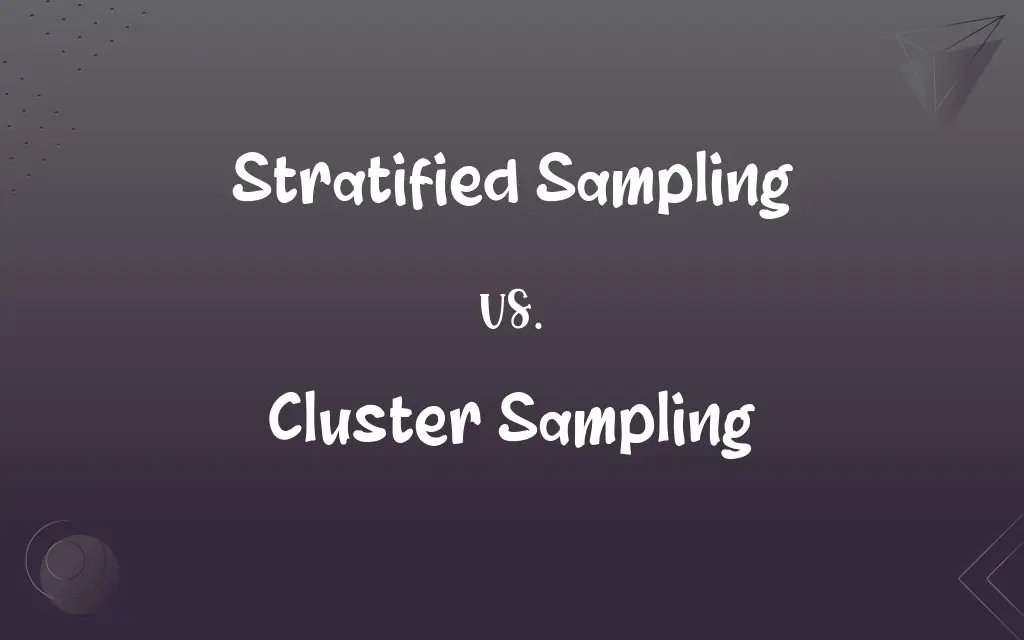Stratified Sampling vs. Cluster Sampling: What's the Difference?
Edited by Janet White || By Harlon Moss || Updated on October 19, 2023
Stratified sampling divides a population into subgroups and samples from each, while cluster sampling divides the population into clusters, sampling entire clusters.

Key Differences
Stratified sampling and cluster sampling are both probability sampling techniques used in research to select representative samples from larger populations. While stratified sampling breaks down the population into homogenous subgroups (or strata) and draws samples from each subgroup, cluster sampling divides the population into heterogeneous clusters and then randomly selects a few clusters to be surveyed in their entirety.
In stratified sampling, the aim is to ensure that each subgroup (stratum) of the population is adequately represented within the sample. For instance, if researching gender differences, a researcher might use stratified sampling to ensure both male and female perspectives are represented equally. On the other hand, cluster sampling is more about convenience and efficiency. A researcher might use cluster sampling when it's too costly or challenging to study the population widely, opting instead to thoroughly study a few clusters.
Stratified sampling requires that the researcher knows the key characteristics of the population to divide it into relevant strata. For example, if studying income levels, the population might be divided into low, middle, and high-income strata. Conversely, with cluster sampling, there's no need to know the individual characteristics of the population members. The division is more spatial or based on certain logistical parameters, like city blocks or schools.
While stratified sampling ensures that each subgroup is represented proportionally in the sample, which can lead to increased accuracy and reduced sampling error, cluster sampling can sometimes introduce more sampling error. This is because the selected clusters might not be entirely representative of the entire population.
Cost and feasibility often play a role in choosing between stratified sampling and cluster sampling. While stratified sampling might provide more precision, it can sometimes be more expensive or time-consuming than cluster sampling, which offers more logistical convenience, especially when dealing with large geographic areas or dispersed populations.
ADVERTISEMENT
Comparison Chart
Definition
Divides population into homogenous subgroups.
Divides population into heterogeneous clusters.
Representation
Ensures representation from each subgroup.
Studies entire clusters without individual representation.
Knowledge of Population
Requires knowledge of population characteristics.
Doesn't require knowledge of individual characteristics.
Sampling Error
Typically has reduced sampling error.
Might introduce more sampling error.
Cost & Feasibility
Can be more precise but potentially more costly.
Can be more logistically convenient and cost-effective.
ADVERTISEMENT
Stratified Sampling and Cluster Sampling Definitions
Stratified Sampling
Reduces sampling bias by proportionate selection.
Stratified sampling was chosen to minimize bias in the gender study.
Cluster Sampling
Surveys entire clusters rather than individuals.
Through cluster sampling, three entire schools were surveyed rather than picking individual students.
Stratified Sampling
Ensures each subgroup's representation in the sample.
Stratified sampling ensured equal representation of both urban and rural perspectives.
Cluster Sampling
Doesn't require detailed population characteristics knowledge.
Using cluster sampling, they surveyed entire neighborhoods without needing demographics.
Stratified Sampling
Enhances precision in certain research contexts.
To gain a clearer picture of regional preferences, they opted for stratified sampling.
Cluster Sampling
A method dividing the population into clusters.
Given the country's vastness, the survey used cluster sampling by province.
Stratified Sampling
Requires knowledge of population characteristics.
Using stratified sampling, the team divided participants based on age groups.
Cluster Sampling
Often used for logistical convenience.
Cluster sampling was ideal for the study as it reduced travel costs.
Stratified Sampling
A method dividing a population into subgroups.
To study income differences, the researcher used stratified sampling based on income brackets.
Cluster Sampling
Can introduce more sampling error.
While efficient, their cluster sampling approach raised concerns about representativeness.
FAQs
How do I ensure the clusters in cluster sampling are diverse?
Random selection of clusters can help ensure diversity and representativeness.
Which sampling method ensures proportional representation?
Stratified sampling ensures proportional representation from each subgroup.
Is cluster sampling more convenient in large geographic studies?
Yes, cluster sampling is often chosen for its logistical convenience in large geographic areas.
Can stratified sampling be more costly than cluster sampling?
Yes, stratified sampling can sometimes be more expensive due to its precision and need for detailed population knowledge.
Which method is best for studying specific subgroups in detail?
Stratified sampling is better for detailed study of specific subgroups.
How is the sample size determined in cluster sampling?
It depends on the number of clusters chosen and the size of each cluster.
Does stratified sampling require knowledge of the population's characteristics?
Yes, stratified sampling requires knowledge of the population's key characteristics to divide it into relevant strata.
Can I combine both sampling methods in one study?
Yes, a combination known as multistage sampling can utilize both methods.
Is cluster sampling always based on geography?
No, while often based on spatial divisions, clusters can be any group, such as schools or companies.
Does stratified sampling involve studying every member of a subgroup?
No, only a random sample from each subgroup is studied in stratified sampling.
Why is stratified sampling considered more precise?
Because it ensures each subgroup's proportional representation, reducing sampling bias.
What are the strata in stratified sampling based on?
Strata can be based on characteristics like age, gender, income, or any relevant categorical variable.
Are strata in stratified sampling heterogeneous or homogenous?
Strata in stratified sampling are homogenous, meaning members within a stratum share similar characteristics.
Does stratified sampling work well with small populations?
It can, but there needs to be clear and meaningful stratification even in smaller populations.
What's the main advantage of stratified sampling over cluster sampling?
Stratified sampling ensures proportional representation, enhancing precision and reducing bias.
Which method is more prone to sampling error?
Cluster sampling can sometimes introduce more sampling error compared to stratified sampling.
Can cluster sampling be used when the population's characteristics are unknown?
Yes, cluster sampling doesn't require detailed knowledge of individual population characteristics.
How many clusters should I choose in cluster sampling?
It varies based on the study's objective, resources, and desired precision.
Can the choice of clusters in cluster sampling introduce bias?
Yes, if clusters chosen aren't representative of the population, it can introduce bias.
In cluster sampling, do all clusters need to be of the same size?
No, clusters in cluster sampling can vary in size.
About Author
Written by
Harlon MossHarlon is a seasoned quality moderator and accomplished content writer for Difference Wiki. An alumnus of the prestigious University of California, he earned his degree in Computer Science. Leveraging his academic background, Harlon brings a meticulous and informed perspective to his work, ensuring content accuracy and excellence.
Edited by
Janet WhiteJanet White has been an esteemed writer and blogger for Difference Wiki. Holding a Master's degree in Science and Medical Journalism from the prestigious Boston University, she has consistently demonstrated her expertise and passion for her field. When she's not immersed in her work, Janet relishes her time exercising, delving into a good book, and cherishing moments with friends and family.































































